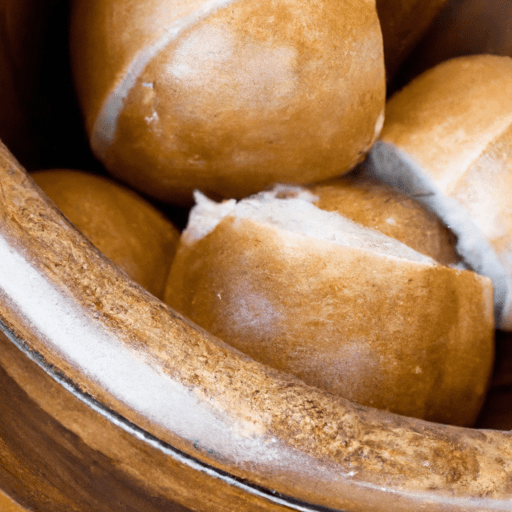The Bread Bowl: A Delicious and Versatile Culinary Innovation
Are you ready to take your dining experience to the next level? Look no further than the humble yet innovative bread bowl! These edible vessels not only add a burst of flavor to your favorite dish; they also bring a unique sense of excitement and creativity to the table. In this blog post, we’ll explore the fascinating world of bread bowls, from their taste and common uses in cooking to their nutritional value and intriguing history.
A Taste Sensation Like No Other
Imagine biting into a warm, crusty piece of bread, only to discover a rich, savory stew or a creamy soup nestled inside. The combination of the soft, tender crumb and the delicious filling creates a symphony of flavors and textures that will tantalize your taste buds. The bread acts as the perfect vehicle, absorbing the flavors of the dish it holds while providing a delightful contrast of textures.
Endless Culinary Possibilities
The versatility of bread bowls knows no bounds. They are commonly used to serve hearty soups, chowders, and stews. Picture a steaming bowl of creamy lobster bisque with chunks of tender lobster meat served in a hollowed-out bread bowl – a decadent treat that combines the best of both worlds.
But why limit yourself to soups? Bread bowls are also a brilliant way to serve salads, dips, and even pasta dishes. Just imagine a Caesar salad with crunchy romaine lettuce, shaved Parmesan, and savory dressing nestled in a bread bowl. The crispy greens and creamy dressing perfectly complement the warm, soft bread, allowing for a delightful culinary experience.
Nutritional Benefits and Considerations
While a bread bowl undoubtedly adds a touch of indulgence to any dish, it’s worth noting its nutritional aspects. Bread is a good source of carbohydrates, which provide energy for our daily activities. The crust of the bread bowl adds a satisfying crunch and texture, thanks to the Maillard reaction during baking.
When it comes to fillings, choosing wisely can turn a bread bowl into a nutritious meal. Opting for vegetable-based soups or stews packed with lean proteins and whole grains ensures a balanced and wholesome dining experience. It’s all about finding the right balance between indulgence and health.
A Brief History and Fun Facts
The origin of bread bowls traces back centuries. In Medieval Europe, hollowing out loaves of bread to use as serving containers was a practical way to make the most of limited resources. The bread acted as both a vessel and a source of sustenance, ensuring nothing went to waste.
In recent times, the bread bowl has gained popularity in the United States, particularly in San Francisco. The famous clam chowder served in a sourdough bread bowl has become an iconic dish associated with the city. Today, bread bowls have evolved to include an array of creative fillings, catering to a variety of tastes and dietary preferences.
Try Your Hand at a Bread Bowl Adventure
Ready to embark on a culinary adventure? Why not try making your own bread bowl? With a few simple ingredients, a little patience, and a touch of creativity, you can transform an ordinary meal into a memorable experience.
Pair your favorite bread dough recipe with a luscious filling, be it a hearty chili, a creamy broccoli cheese soup, or a chunky tomato bisque. Experiment with different flavors, textures, and presentations to create your unique masterpiece.
Note: If you prefer not to bake your own bread bowl from scratch, many bakeries and grocery stores offer pre-made options.
Next time you’re looking to add an extra thrill to your dining experience, consider the magical allure of the bread bowl. With its delectable taste, endless culinary possibilities, and rich history, it’s a culinary treasure waiting to be savored. Happy cooking and bon appétit!
Remember to check out our other blog posts for more exciting twists on classic dishes and delectable food inspiration. Stay tuned for our upcoming recipes and kitchen tips!
Bread Bowl
Origin: Bread bowls have a long history and can be traced back to the Middle Ages in Europe. They were commonly used as a way to serve food and soups, particularly in countries such as England, France, and Ireland. The practice of serving food in bread bowls eventually made its way to the United States.
Common Uses: The most common use of a bread bowl is as a container for serving soups, stews, chili, or creamy dips. The hollowed-out bread acts as both a vessel and an edible accompaniment to the dish. They are also used for serving dishes like clam chowder, gumbo, and French onion soup.
Nutritional Benefits: The nutritional benefits of a bread bowl primarily depend on the type of bread used. Whole grain or whole wheat bread bowls can provide dietary fiber, B vitamins, and minerals such as iron and magnesium. However, it’s important to note that the bread itself may contribute to the calorie content of the dish.
Unique Properties: A notable characteristic of a bread bowl is its ability to absorb the flavors of the dish it contains, adding an additional layer of taste. The crust of the bread can become crustier while the interior softens, providing a contrast in textures.
Historical Significance: Bread bowls have deep cultural roots and have been used for centuries to serve meals. In some historical contexts, bread was considered a vital staple food, and using it as a vessel to contain other foods helped make the most of every ingredient. Today, bread bowls continue to be popular in both casual and fine dining settings, adding a touch of novelty to a dish.




Use the share button below if you liked it.
It makes me smile, when I see it.